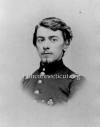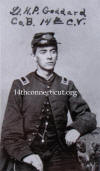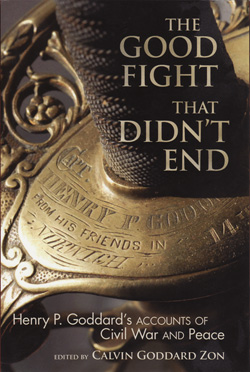Company G, Fourteenth Regiment Connecticut
Volunteer Infantry 1862 - 1865, Inc.
A 501 (C) 3 Historic Preservation and
Educational Organization Since 1997

Henry Perkins Goddard


To Read Goddard's
Gettysburg Harper's Weekly Article


To Read Goddard's
Book 14th C.V. Regimental Reminiscences Of The War Of The
Rebellion


To Read Goddard's
Book Memorial To Deceased Officers of The Fourteenth
Regiment, Connecticut Volunteers


Henry
Perkins Goddard was a 20-year-old writer for his hometown newspaper, the Norwich
Bulletin, when he exchanged his pen for a sword and was commissioned as a second
lieutenant the "Connecticut Squadron" of the 2nd New York Volunteer Cavalry in
March 1862. After participating in several skirmishes in the northern Virginia in that
regiment, led by the daring and reckless Judson "Kill Cavalry" Kilpatrick, he
resigned in May upon the death of his father and for other personal reasons.
In June 1862, he was commissioned sergeant-major in the newly organized 14th
Connecticut Volunteer Infantry, where he rose to the rank of captain shortly
before resigning for health reasons in April 1864. His wartime experiences are
recorded in his reports to the Norwich Bulletin, but mostly in his letters to
his mother, Mary Goddard; his father, Levi Goddard, a prominent lawyer; his
older sister, Julia Piatt; his younger sister, Mary ("May") Goddard, later the
wife of Louis Comfort Tiffany; and his older brother, Alfred Mitchell Goddard,
who he pleads with not to return from his work as an engineer in Hawaii to join
the war effort. Motivated by guilt and a hatred of slavery, his brother returned
and was commissioned a first lieutenant in the 8th Connecticut Infantry. He was
killed while rallying his men in his first engagement in May 1864 near
Petersburg.
Goddard and the regiment got their "baptism of fire" at
Antietam. At Fredericksburg,
Goddard's heroism saved the life of the regiment's commander, Col. Sanford
Perkins, and his bullet-ridden canteen probably saved his own life. At Chancellorsville, then-Lieutenant Goddard was felled by a
shell fragment as he lined up his men against the surprise attack by Stonewall
Jackson. Taking leave from the regiment to recuperate from his wounds, he served
as a staff officer for Maj. Gen. Dan Tyler in Wilmington, Del.,
in the summer of 1863. He regretted his absence from the Union victory at Gettysburg, but his vivid
account of Pickett's charge, based on interviewing 14th CVI comrades, was
published in Harper's Weekly.
Returning to the battle-scarred regiment in the fall of 1863, he observed how
the unit of volunteers had been changed by an influx of unruly draftees and
substitutes who were prone to desert. Once more, he reinvented himself, this
time as a brigade artillery officer. He came under fire while repositioning
artillery at the Battle of Morton's Ford in February 1864. Unable to resume the
rigors of the infantry due to his health, he reluctantly resigned his commission
in late April 1864 after Lt. Gen. Ulysses S. Grant, the army's new commander,
ordered all former infantry officers back into their units for the drive toward Richmond.
Goddard observed Abraham Lincoln on four occasions, the first time as a reporter
when he covered Lincoln's campaign speech in Norwich in the spring of
1860. Interviewing key players after the war, he reported little-known and
unpublished anecdotes of Lincoln and also of
Samuel Clemens, his friend and neighbor in Hartford during the 1870s. He also described
his encounters with such notables as George Armstrong Custer, Joseph Hooker,
George McClellan, Ambrose Burnside, Irwin McDowell, Dan Tyler, Grant, and
Kilpatrick.
Inspired by Lincoln's
"freedom-breathing" Emancipation Proclamation, he described an army bitterly
divided over the issue of race and abolition.. As for the 14th Connecticut,
however, he said of an April 1863 election for Connecticut governor that the
regiment was so disgusted with "the miserable Copperhead Democracy in
Connecticut, that should Tom Seymour be elected governor, or the draft resisted,
we will whip the traitors in front and then go to Connecticut to drive Tom
Seymour and his crew into Long Island Sound."
After the war, he moved from Norwich to Hartford in 1867 where he worked as an
insurance executive. Following the death of his first wife, Goddard remarried
and moved to Baltimore, Md., in 1882, where he continued to write for
newspapers and was president of the Shakespeare Club. He became friends with
prominent Union and ex-Confederate officers and
with the beautiful Confederate sympathizer and blockade runner Hetty Cary.
Goddard defended the civil rights of African Americans in what he called the
"southern state" of Maryland
and denounced the "Negrophobia" of the state's Democratic political machine. He
ran for the Maryland
legislature in 1907 as a progressive Republican on the platform of "an honest
election law" that included a ballot which semi-literate African Americans could
decipher. He lost the election, but was grateful for the support of some "very
dear old Confederate veterans who were as magnanimous in peace as they were
brave in war."
Traveling to Virginia and the Deep South,
he described the uneven progress of Reconstruction, the lasting wounds of the
war, and reconciliation among veterans of both camps. He reported on the cast of
characters and activities at 14th
Connecticut
reunions. He compared the different life styles in postwar
New England and the South.
Goddard was a graduate of the
Norwich
Free Academy,
which remains the city's main public high school. His grandfather was Calvin
Goddard, a Connecticut
jurist and member of Congress during the presidency of Thomas Jefferson. He is
remembered for getting Congress to approve pensions for African Americans
veterans of the Revolutionary War.
Goddard died in Baltimore on April 5, 1916, of
pneumonia, at age 73, and was buried in
Arlington
National
Cemetery
with military honors and the sound of a trumpet. His attending physician was his
son and only child, Calvin Hooker Goddard, who is best known as the pioneer of
the science of forensic ballistics in the 1920s and 1930s. His middle name
derives from his mother, Lida Acheson Goddard, who was a cousin of Maj. Gen.
Joseph Hooker, and a direct descendant of the Rev. Thomas Hooker, founder of Connecticut
colony.
Biography by Calvin Goddard Zon
To Learn More About Henry Perkins Goddard Please Visit
www.thegoodfight.us

![]()
![]()